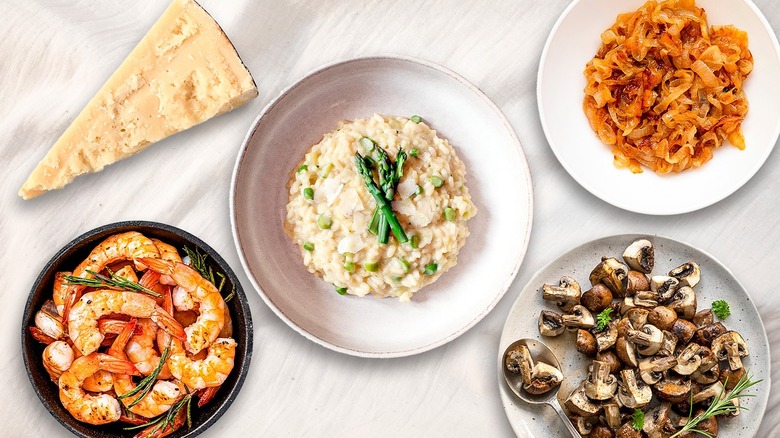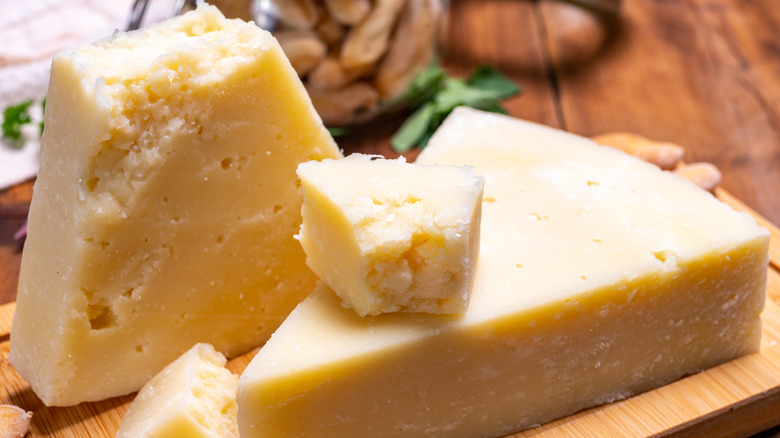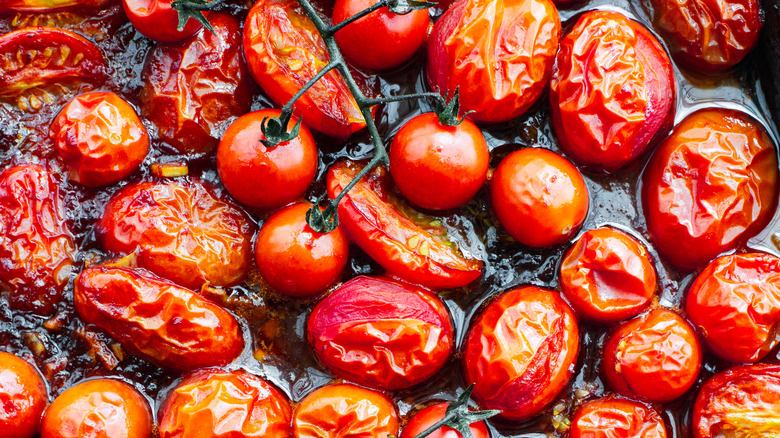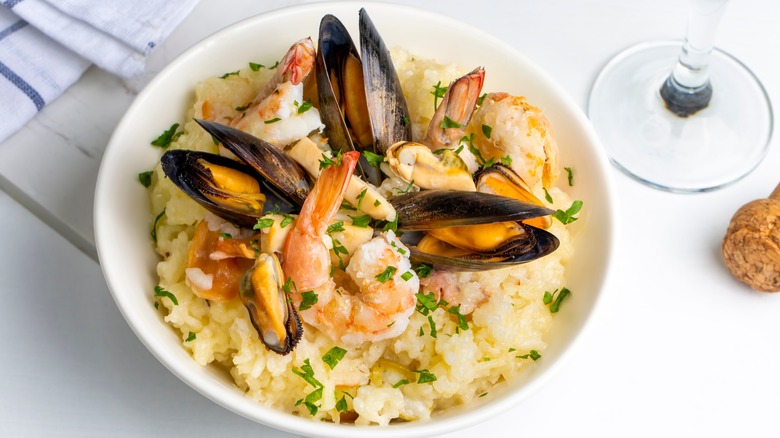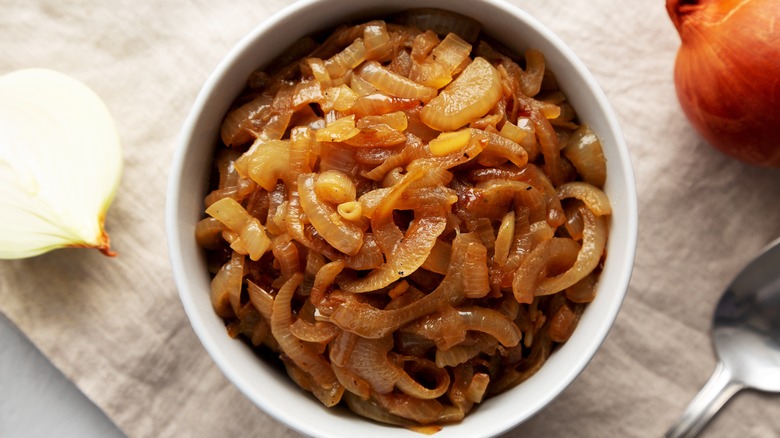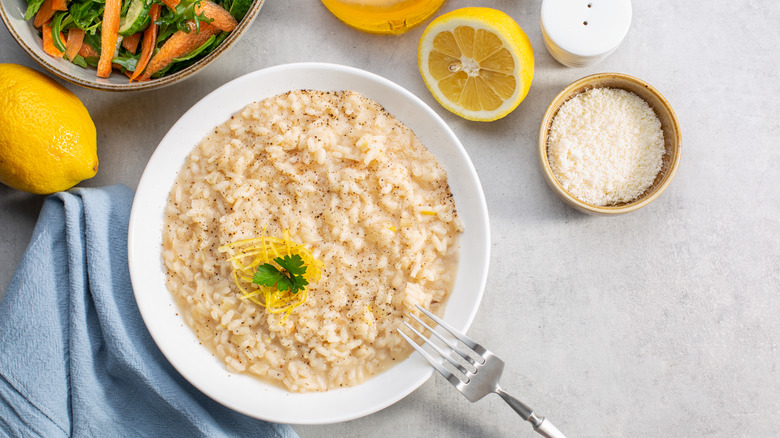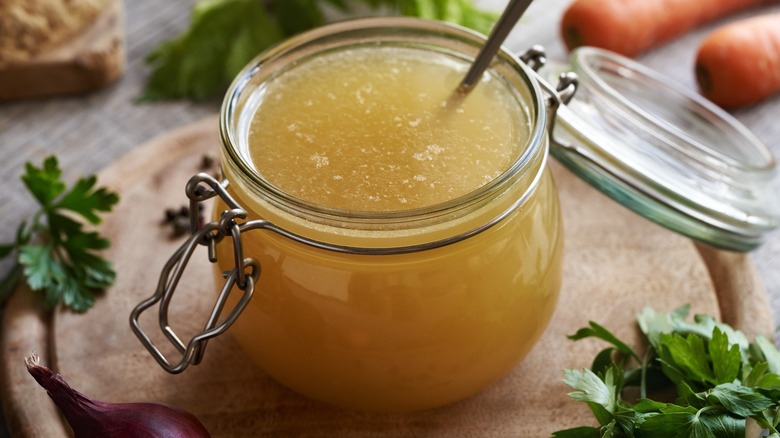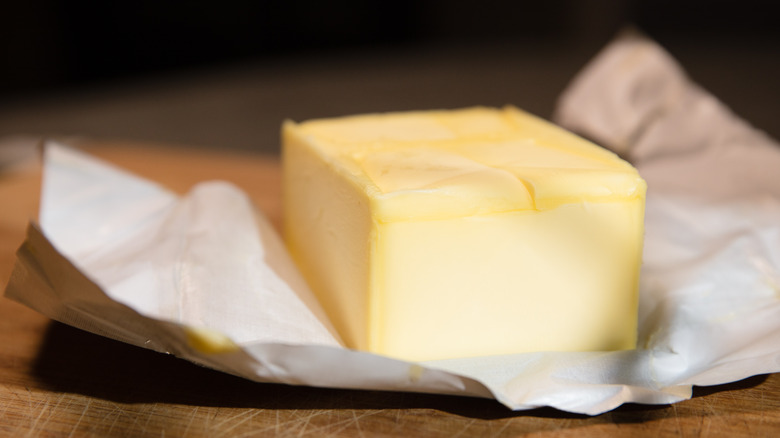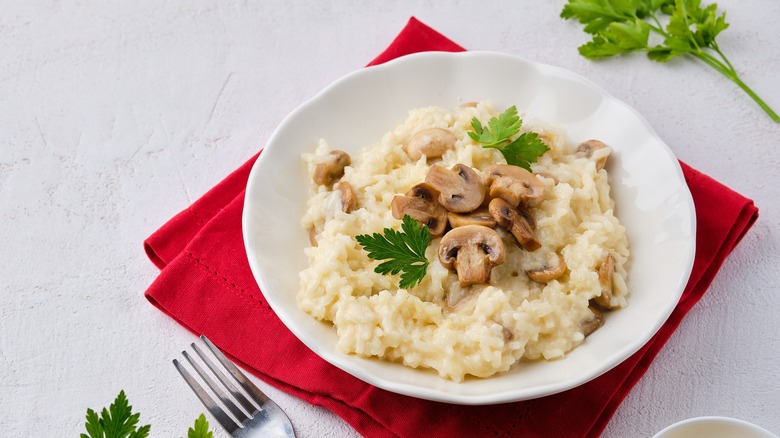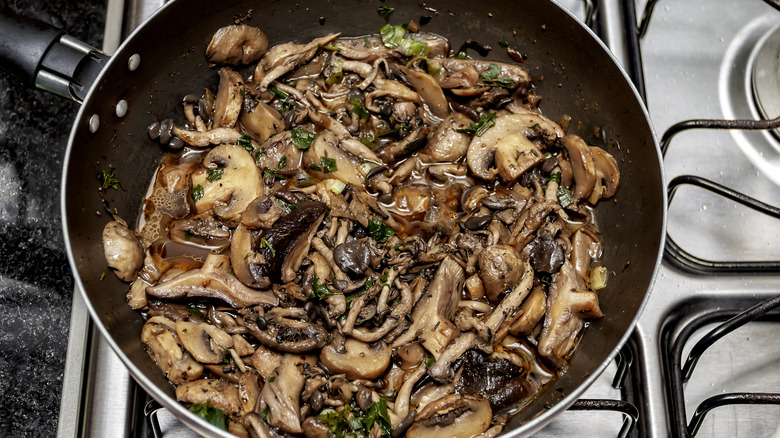11 Absolute Best Ingredients For Restaurant-Quality Risotto
There's nothing more satisfying than digging into a warm bowl of risotto. It's creamy, rich, and savory, making it one of the most luxurious meals you can prepare. In fact, risotto is so good that even the most basic recipes — made of rice, stock, onions, butter, and Parmesan cheese — taste amazing. But why stop there? By incorporating other ingredients into your risotto, you can create a dish that tastes like it was professionally made.
In general, the best ingredients for making restaurant-quality risotto will balance the richness of the meal. For example, when it comes to flavor, ingredients with salty, sweet, or umami notes can complement the decadence of risotto. Similarly, ingredients that are meaty or crispy work well with risotto, as they can help round out the dish. In other cases, the ingredients traditionally used in risotto can be replaced with other items, giving your meal a boost of flavor and depth.
However, with so many possible risotto add-ins to choose from, how do you know which ones to use? To find out, we chatted with professional restaurant chefs for expert tips and guidance. Lauren DeSteno is the executive chef of Ai Fiori, an Italian restaurant in New York City. Jesus Arevalo is the executive chef at Sogno, an Italian restaurant in Boston. Rory Lee is the executive chef at Midnight Morning, a restaurant and bar in Boston. Read on to learn about their top picks, plus the best way to use each one in your next batch of homemade risotto.
Pecorino Romano
Cheese makes everything better, and risotto is no exception. The most common option is grated Parmesan cheese, which emphasizes the creaminess of the dish. It also provides a delicious salty and nutty flavor that simply can't be beat. But if you want to take things up a notch, try swapping Parmesan cheese for Pecorino Romano. If you're unfamiliar with Pecorino Romano, it's an Italian cheese made of sheep's milk. It's aged for approximately eight to 12 months, which gives it a hard texture. On the other hand, Parmesan cheese is made of cow's milk and aged for at least 10 months.
Both cheeses are tasty in risotto, and ultimately, it depends on the flavor profile you're going for. However, if you're used to making risotto with Parmesan, you might want to switch things up and add Pecorino Romano. "Sheep's milk has a higher fat content than cow's milk; that, combined with some shorter aging times, can give Pecorino a richer/creamier taste and texture," says Lauren DeSteno. Plus, there are more varieties of Pecorino Romano than Parmesan cheese, "so you have a greater variety of flavor/texture profiles to choose from," she adds.
Egg
If you'd like to make your risotto look like it came from a high-end restaurant, top each serving with a fried or poached egg. This will "add a richness to the meal that further elevates its creaminess," says Jesus Arevalo. What's more, if you prepare the egg with a runny yolk and break it on top of the risotto, it will create a mouthwatering visual. "Even if you have loaded the risotto with butter and cheese, seeing the bright orange yolk spilling over the rice makes it feel almost luxurious," says Lauren DeSteno. It also doesn't hurt that eggs are a source of protein, so they'll make your risotto extra filling.
To get the most out of this unique risotto topping, take a moment to fine-tune your egg cooking skills. For example, to properly make a sunny-side-up egg, fry it for one to two minutes while scooping fat on the white portion. This will yield a fried egg with cooked egg whites and a runny yolk. Also, always use a non-stick pan with plenty of fat to prevent the egg from sticking. It's the best way to ensure you can slide the egg right out of the pan and onto your risotto. Alternatively, if you'd like to poach an egg, crack it into a mug first, which will let you easily add it to boiling water. It's also a good idea to use a slotted spoon to remove the egg, as this will help drain the cooking water.
Blistered cherry tomatoes
Aside from adding a pop of color, blistered cherry tomatoes will instantly elevate the flavor of your risotto. "Tomatoes are naturally high in the amino acid glutamate or glutamic acid, one of the compounds in MSG," says Rory Lee. This amino acid gives tomatoes a delightful umami flavor, which works beautifully with risotto. Additionally, "blistering the cherry tomato softens the fruit and concentrates that tomato a flavor a little bit," adds Lee.
If you're new to blistering cherry tomatoes, you'll be glad to hear that the process is fairly simple. One method is to toss the tomatoes in olive oil, spread them on a sheet pan lined with parchment paper, then broil them in the oven "until the skin splits and starts to char," as recommended by Lee. You can also blister cherry tomatoes on the stovetop; simply warm oil in a pan over medium-high heat, add the tomatoes, then let them cook without touching them. After about five minutes, the tomatoes will begin to blister and burst, creating the perfect topping for your risotto. "A little alteration to this is to toss the tomatoes with some lemon zest or garlic, maybe basil leaves, to really enhance the overall flavor," says Lee.
Seafood
The next time you're making risotto, serve it with your favorite seafood. The combination is so elegant and delicious that you might feel like you're eating at a fancy restaurant. The trick is to add seafood at the end of the cooking process, as this will prevent it from overcooking, says Lauren DeSteno. For instance, consider topping each serving of risotto with cooked lobster or crab meat, as recommended by DeSteno. You can also "saute any raw seafood on the side (when the risotto is nearly ready) in some garlic oil and deglaze with white wine before adding to the risotto," she adds. If you enjoy combining different types of seafood, make a seafood risotto by adding mussels, scallops, calamari, and shrimp in the last few minutes of cooking.
To infuse your risotto with even more seafood flavor, prepare a seafood stock from fish bones or the shells of lobster, shrimp, or crab, then use the liquid to make the dish, says DeSteno. It's an excellent way to get the most out of your food scraps and stretch your seafood even further. Note that you can add other ingredients to your stock, such as carrot peels and celery roots, for even more flavor and nutrition. One more thing to keep in mind: Shellfish stock becomes foamy during the cooking process, so be sure to skim it off as needed. It's also a good idea to strain the stock to avoid bits of shells in your risotto.
Caramelized onions
If you want to prepare a restaurant-worthy risotto, take the time to caramelize onions. The process involves cooking onions low and slow, helping bring out the vegetable's natural sugars. When added to risotto, the sweetness of caramelized onions will not only add extra flavor but balance the saltiness and fattiness of the dish as well, according to Jesus Arevalo. Additionally, there are different techniques for preparing the ingredient. For instance, if you'd like to add an attractive topping to your risotto, slice the onions into strips before cooking them. If you'd like to use caramelized onions as a mix-in, it's best to dice the onions "so you can easily get them in each spoon of risotto," says Lauren DeSteno.
Most caramelized onion recipes involve adding salt early on in the cooking process. You're welcome to follow this technique but know that you can also salt the onions at the end. "I feel that when you do not salt them immediately, it gives the onions a chance to caramelize gently," points out DeSteno. That's because the onions still have water, which slows down any potential burning in the pan, she adds. Regardless of your preferred method, caramelizing onions takes time — about 45 minutes — so be sure to consider this when planning your meal.
If you'd like to save space on the stovetop, try caramelizing onions in the oven. The method involves tossing sliced onions with olive oil, brown sugar, salt, and pepper, then placing them in a baking dish covered with foil. Roast the onions for about an hour, regularly tossing them to ensure even cooking. The process will take some time, but it's helpful if you're cooking up a storm and need more real estate on the stovetop.
Lemon juice
One of the simplest ways to elevate homemade risotto is to incorporate lemon. As Lauren DeSteno notes, more subtle ingredients can get lost in the richness of the dish, but acids can brighten things up. "Lemon is a great ingredient when you want some acid, but not necessarily a highly flavored one, like vinegar, for example," says DeSteno. Jesus Arevalo echoes this notion, sharing that "adding in a citrus to a heartier, rich dish like risotto will also help cut through some of the overpowering fattiness."
There are several ways to enhance risotto with lemon. Once your risotto is done cooking, add lemon juice and stir well. It's important to avoid adding lemon juice early on in the cooking process, as this will dull the juice's flavor, says DeSteno. You can also top each individual serving with a bit of lemon juice. Freshly squeezed juice will always taste best, but the bottled kind can do in a pinch. When squeezing a fresh lemon, always use a lemon squeezer or strainer to catch any seeds. You can also squeeze the juice in a separate bowl, then scoop out the seeds with a spoon before adding the juice to the risotto.
If you're craving less acidity and more lemon flavor, garnish the meal with lemon zest. Just be sure to avoid using too much, as the lemon notes might overpower the risotto. Typically, for a single batch of risotto, you'll need the zest of one lemon. Another option is to combine olive oil with lemon zest, then use the oil to cook the dish, says DeSteno.
High-quality stock or broth
Whether you prefer making risotto with broth or stock, it's worth using a high-quality product. After all, it's a main ingredient in risotto, where it significantly contributes to the flavor and texture of the meal. To find a high-quality broth or stock in stores, look for one with whole, minimal ingredients. Also, consider avoiding products with too much salt or seasonings, as this might add unwanted flavors to your risotto.
If possible, make your own broth or stock. Rory Lee prefers mushroom broth or chicken stock, as they have more flavor than vegetable broth but aren't as overpowering as veal or beef stock. Likewise, "they both do a nice job complementing a lot of ingredients," adds Lee. To make your own chicken stock, add chicken bones, onions, carrots, and celery in water for four to six hours, he says. If you'd like to make mushroom broth for risotto, "just replace the chicken bones with leftover mushroom stems or whole mushrooms," says Lee. Simmer the broth for two to four hours, and you'll have an umami-rich liquid for your risotto.
Wine
Many risotto recipes involve toasting the rice in melted butter, then deglazing the pan with wine. This isn't exactly a necessary step, but if you want to create a restaurant-quality meal, it's a good idea to do it. That's because it will add more depth to the overall flavor of your risotto, according to Rory Lee. The most common option is white wine, particularly one that is dry, crisp, and unoaked. However, you're also welcome to use unoaked chardonnay or light red wines, like a pinot noir.
When making risotto, keep in mind that wine is used to add a bit of flavor. It's not a main ingredient, so try not to overdo it. "Adding too much wine will make your risotto too sweet; it should be more of an accent flavor to complement the butter, cheese, and stock," says Lee. However, if you don't drink alcohol and want to avoid this ingredient, deglaze the pan with stock or broth instead.
High-quality butter
As butter is a staple ingredient in risotto, it's worth using the best you can find. Compared to standard, cheaper butter, quality versions have a higher percentage of butterfat, making them more yellow in color, explains Rory Lee. It's also richer, creamier, and softer in texture due to the extra fat, he says. With that in mind, there are a few ways to find the best quality butter at the grocery store. Start by checking the fat content on the nutrition label. The average stick of butter has about 80% of butterfat, so you'll want to choose a product that has more than this amount — about 82% or 85%. Also, look for a product with a minimal ingredient list. Avoid butter with additives, like canola oil or beta-carotene, which are used to improve spread ability and color, respectively.
Even when using high-quality butter in your risotto, it's still important to be mindful of timing. "Add all butter and cheese to the dish 30 seconds before it's finished," says Jesus Arevalo. "Otherwise, adding too early will lead to a greasy product and take away from all those great starches we developed during the cooking process."
Herbs
Another way to make your restaurant-worthy risotto is to garnish it with fresh herbs. This will add flavor and color to the meal, making it more aesthetically pleasing. "Parsley is by far the most common herb to use for garnish," says Rory Lee. "It has a relatively subtle flavor, soft texture, and stays green for a long time after cutting it." You can also use basil, which is frequently used in Italian cuisine. Note that basil has a stronger flavor than parsley, so you'll want to avoid using too much.
You're not limited to parsley and basil. For a unique take on the meal, try incorporating sturdier herbs like rosemary, thyme, or sage. These options have a deep, earthy flavor, making them ideal for risotto that will be enjoyed during the holiday season or cooler months. They work especially in with seasonal iterations of the dish, such as butternut squash risotto or autumn harvest pumpkin risotto. To use these herbs in risotto, mix them in at the end of the cooking process or briefly cook them in butter for an elegant garnish.
Mushrooms
Mushrooms, like tomatoes, will add a punch of umami to your risotto. That's because they're high in glutamate, the amino acid responsible for their umami flavor. Mushrooms also have a meaty, chewy texture that will contrast the creaminess of risotto, creating a wonderfully balanced dish. The only catch is that mushrooms are high in water, so they often become soggy once cooked.
One of the best tips for cooking mushrooms is to dry saute them first; this will help reduce excess moisture. Next, add a bit of oil, then sear the mushrooms until browned, caramelized, and crispy. You can also roast the mushrooms after dry sautéing them on the stovetop. In this case, you'll want to drain the pan after 10 to 20 minutes, which will help them crisp up. However, don't be so quick to toss the liquid, as it can be combined with your broth or stock for additional umami flavor. Once your mushrooms are cooked, mix them into your finished risotto or spoon them on top just before serving.
